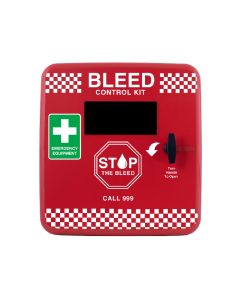More Information
To learn more about our Bleed Control Kits, get in touch with our friendly & knowledgeable team by calling 0161 776 7422. Alternatively, fill out our Contact Us form and we'll respond to you as soon as possible.
What is bleed control equipment used for?
Bleed control equipment is designed to treat catastrophic bleeding immediately after a serious injury. These products support fast intervention in incidents involving stabbings, industrial accidents, road collisions, or falls, helping responders manage blood loss before Emergency Medical Services (EMS) arrive.
What is included in a bleed control kit?
Bleed control kits contain specialist items to manage severe external bleeding. These include tourniquets, haemostatic gauze, trauma dressings, Tuff cut scissors, nitrile gloves, CPR face shields, and clear step-by-step instructions. Each item supports immediate response during a life-threatening emergency.
For a full breakdown of kit contents and product options, visit our Bleed Control Product Overviews page.
Which bleed control kit is best for my environment?
The Bleed Control Kit with Tourniquets supports rapid response to severe bleeding in settings such as schools, workplaces, leisure facilities, and public venues. It includes multiple tourniquets, trauma dressings, and essential barrier protection, aiding responders during incidents involving multiple casualties or limb injuries.
The CELOX Bleed Control and Emergency Trauma Kit is suited to high-risk environments, including construction sites, transport hubs, and city centres. It includes Celox Rapid haemostatic gauze, an SOF Tactical Tourniquet, and a Russell Chest Seal™, providing advanced tools for managing complex trauma.
For full product details and guidance on selecting the right setup, visit our Bleed Control Product Overviews page.
Where should bleed control equipment be installed?
Bleed control kits and cabinets must be installed in locations where serious injuries are most likely to occur and where first responders need immediate access. This includes:
- School entrances, sports halls, and playgrounds
- Construction sites and workshop areas
- Public venues, event spaces, and city centres
- Transport hubs such as train stations and bus terminals
- Alongside defibrillators and first aid points in public buildings
Wall-mounted cabinets ensure kits remain protected, visible, and ready to use, 24/7. Clear signage and consistent placement support fast identification during high-pressure emergencies.
How do you use a bleed control kit in an emergency?
Bleed control kits and cabinets must be installed in locations where serious injuries are most likely to occur and where first responders need immediate access. This includes:
- School entrances, sports halls, and playgrounds
- Construction sites and workshop areas
- Public venues, event spaces, and city centres
- Transport hubs such as train stations and bus terminals
- Alongside defibrillators and first aid points in public buildings
Wall-mounted cabinets ensure kits remain protected, visible, and ready to use, 24/7. Clear signage and consistent placement support fast identification during high-pressure emergencies.
When should I apply a tourniquet from a bleed control kit?
Apply a tourniquet when bleeding is severe and located on a limb, and when direct pressure is not enough to control it. Position the tourniquet high above the wound, tighten it until the bleeding stops, and record the application time using the marker included in the kit.


